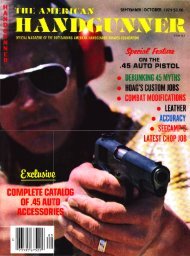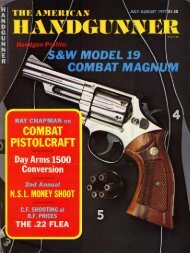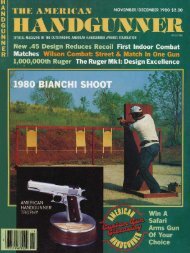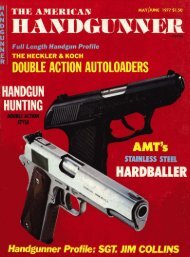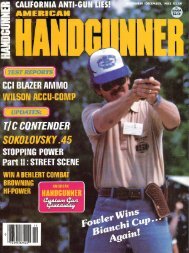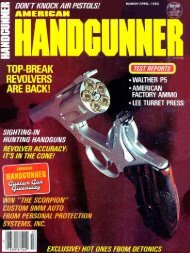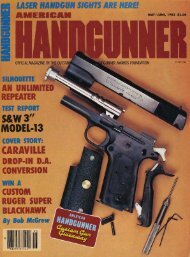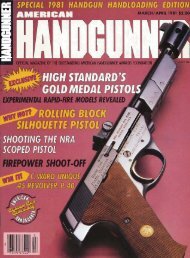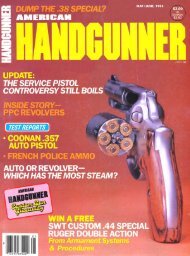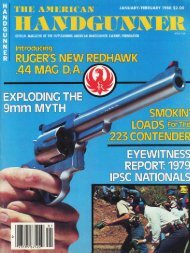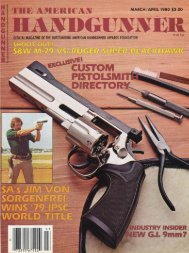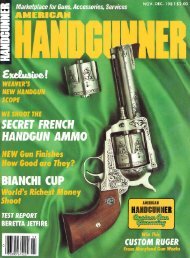Above: Combat Master Leonard Knightfiring in the first IPSC U.S. National PracticalPistol Championships, June, 1977.When the smoke had cleared, Leonardhad taken second. Center: Here's BillNorth running the wild Surprise AssaultCourse. Notice his thumb on safety andhis trigger finger outside of the triggerguard. Pistolcraft can be exciting. Right:Jeff Cooper, IPSC President, bustingturning targets at a fast, 2 seconds each.various Marks, gave excellent servicethrough innumerable campaigns all overthe world. Right up through 1957, whenthe British finally switched to the BrowningP-35 self-loading pistol, they werenot about to give up their DA servicerevolvers.In similar fashion, it took the selfloadingpistol quite a while to catch on inthis country. One cannot help but beamazed at the endless condemnation ofthe autoloading pistol, both aloud and inprint, from 1900 right up to the presenttime. The situation is now improving, buta large segment of the <strong>American</strong> shootingfraternity still views any self-loading pistolwith dark suspicion.In the early days of the autoloader, sayfrom 1892 till 1900, this criticism is understandable.The early autopistols andtheir ammunition left a lot to be desired inthe way of reliability. But from 1900on, a continuing list of excellent weaponsand improved smokeless ammunitionrendered the ridicule of the revolver manpointless and outdated.In 1920 Captain Hugh B. C. Pollard, anEnglishman, in his excellent little booktitled "Automatic Pistols," made a very20good case for the superiority of the autoloadingpistol over the revolver as acombat arm. From a practical viewpoint,Pollard heavily stressed the idea that"quick work with a swift pistol" shouldbe the accepted goal. Again, he makesthe point several times, that the essentialnature of all pistols is that of "weaponsfor quick use at close quarters."Captain H. -W. McBride said much thesame thing in 1935 in his entertainingbook "A Rifleman Went to War." In thechapter "The Pistol in War," he outlinedsome advanced ideas on how the handgunshould be handled in a combat situation.McBridge emphasized the handiness ofthe pistol as a defensive tool, and its usefulnessin close-in, hand-to-hand fighting.The quick reloading capabilities of theautopistol were pointed out, as were theexcellent qualities of the Colt 1911, .45Auto. McBride also suggests that theproper way to recharge an autoloadingpistol in combat is to keep a live roundchambered while making the magazineswitch! That last point was very innovativefor 1935, and is quite familiar to allfreestyle practical shooters of today.Texts dealing with practical shooting,or at least partially dealing with it, seemto have been quite popular during the1930's. Ed McGivern's book, "Fast andFancy Revolver Shooting," was publishedin this period, as was J. H. Fitzgerald'sbook "Shooting." Both of theseworks dealt quite extensively with thesubject of double action revolver shootingas it related to the defensive use of theweapon.the 1930's, reaching its peak during theyears of World War 11, and fading again inthe late 40's. The next burst of progressdidn't occur until the early 1960's, butthat's getting ahead of the story.In 1942, the first classic text of themodern era on practical pistol shootingappeared on the scene. It was authoredjointly by Captain William E. Fairbairnand Captain Eric A. Sykes, both formerlyof the Shanghai Municipal Police, andwas titled "Shooting to Live." This littlegem of a book, only 96 pages from front toback, first set forth many of the principleswe now think of as "modern" in origin.Among other things, Fairbairn andSykes advocated use of the Colt 1911self-loader in .45 ACP for general policeand military service. They also taught twohand eye level shooting, firing two-shotbursts at all man targets, and emphasizedthe importance of stressing close rangespeed shooting on surprise targets. Manyof these concepts were so far ahead oftheir time that they have only been generallyaccepted comparatively recently.Both Fairbairn and Sykes were eminentlyqualified to write such a book onpistolcraft. During a 12% year periodwhen their training techniques were inuse,'the Shanghai Police engaged in 666armed encounters with criminals. That's4.4 shootings per month, with a net resultof 260 killed and 193 wounded crooks. Atthe same time, there were 42 killedand 100 wounded officers, quite a favorableratio.One verv innovative idea that has beenInterest in practical handgun shooting . revived today is the indoor surprise reacseemsto have gained momentum during tion range devised by Fairbairn andAMERICAN HANDGUNNER JULYIAUGUST <strong>1978</strong>
Sykes back in the 1930's. This providedvery realistic conditions, with dim lighting,bobbing silhouettes, moving targets,and friend or foe situations, plus ahealthy measure of mental stress.During World War 11, Rex Applegateset up a very elaborate indoor reactionrange, very appropriately called "TheHouse of Horrors," for training U.S.Army personnel. This included bloodchilling sound effects and dramatic lifelikekill or be killed scenarios.Jeff Cooper has constructed a modernversion at his Gunsite Ranch which hecalls "The Fun House." His layout allowsfiring with full power loads, a 360 degreefield of fire, and quickly changeable setups for variety. The training provided onthis type of range is invaluable for thepolice officer or military man.Following close on the heels of "Shootingto Live" came another advanced textby then Captain Rex Applegate. His book"Kill or Get Killed," was published in1943, and included information on unarmedcombat, knife fighting, and closecombat use of shoulder weapons, as wellas much thought-provoking informationon practical pistol shooting. Applegatestudied under Fairbairn early in WorldWar 11, and many of his concepts canbe traced back to the methods used byFairbairn and Sykes in their trainingprograms.This is approximately where mattersstood for the next fifteen years. The late40's rolled by and then the early 50's. Bythis time the fast draw game, inspired bythe many TV westerns then in vogue, wassweeping the country. This activity,complete with SA revolvers, blanks, waxAMERICAN HANDGUNNER JULYIAUGUST <strong>1978</strong>bullets, boots, and ten gallon hats did notproduce any worthwhile innovations of apractical nature, but it got a man into theact who did.Jeff Cooper, a retired Marine CorpsLieutenant Colonel with combat experiencein the South Pacific during WorldWar 11, and the Korean War, enters thepicture around 1955. At about this timeCooper helped promote a number ofquick draw contests near Big Bear Lake,California, with an important difference.In these man against man matches, allweapon types, SA, DA, and auto, wereallowed to compete equally, not justsingle action revolvers. Additionally, fullpower service ammo was required, notblanks or wax bullets. These shoots werevery simple affairs, usually at sevenyards, and the targets were inflated toyballoons. All a competitor had to do wasdraw and burst his balloon ahead of hisopponent. The man shooting down allcomers walked away with the prizemoney.This was a stimulating game, but verylimited in scope. It wasn't long before themore adventuresome participants werebored with the routine and looking forsomething new. With that in mind, JeffCooper set out to oblige them.Soon Cooper was putting together contestsof a type and nature that had neverbeen dreamed of before. Some contestswere man against man, while othersmight be scored or timed, but all of themwere designed to simulate the realities ofclose range combat with the handgun.Another important and unheard of innovationwas an almost total lack of restrictionson the contestant. As long as heused a serviceable weapon of adequatepower, and approached the problem in asafe manner, he could solve that problemin any fashion he deemed best. Diversitywas the name of the game, and the shooterwith a good imagination was free to trysomething new in the name of greaterefficiency.Needless to say, this sort of programgenerated quite a bit of enthusiasm andinterest. Before long clubs sprang intobeing in different areas of SouthernCalifornia, all more or less participatingin the new sport of freestyle practical pistolshooting. The ideas and concepts ofthe new sport were still quite sketchy andnot widely understood, even thoughinterest was still growing. So, in 1961 Jeffhelped found the Southwest Combat PistolLeague, later modified to the SouthwestPistol League, to give order anddirection to the program.As things progressed, and a little timewent by, the virtues of freestyle combatshooting became apparent. With no setroutine to slavishly drill for, each individualslowly became a more rounded andversatile performer, since each matchcalled for a slightly different approach. Inlike fashion, equipment could not be overspecialized, it had to be adaptable enoughto meet a variety of situations.Since few restrictions were placedupon the performer, the more innovativeshooters began to experiment with improvedequipment and techniques. Theclassic example in this'area, as everyonenow knows, is the Weaver Stance. In themid-1950's everyone shot one handed foralmost all pistol problems, this includeddeliberate fire and speed situations. The2 1
- Page 1: " I THE AMERICANAUNOFFICIAL MAGAZIN
- Page 6 and 7: INDUSTRY INSIDERBy MASSAD F. AYOOB
- Page 8 and 9: -NIARLES C THOMAS-PUBLISHEI- I?r ?I
- Page 10 and 11: -'.. : ,,. . .{b-.$, \:..', -.,.IOO
- Page 12 and 13: SNUBmNOSEDREVOLVER1 FREE: Targets a
- Page 14 and 15: PA DISSENTING VIEW ON MAGAZINE SAFE
- Page 16 and 17: The New PistolcraftAt Jeff Cooper's
- Page 19: The Evolution ofModem PistolcraftBy
- Page 23 and 24: Charter544 Bi^gShot LoadsBy GEORGE
- Page 25 and 26: Throat opening can be done with cas
- Page 27 and 28: Now you see it trimmed down to mana
- Page 29 and 30: , .- - A --.-ng. As analternative,
- Page 31 and 32: Little is known of his second ventu
- Page 33 and 34: engaging the cartridge case groove
- Page 35 and 36: AMERICAN HANDGUNNER . JULYIAUGUST 1
- Page 37 and 38: II ShootingIll Law EnforcementPart
- Page 39 and 40: neared completion, factory manageme
- Page 41 and 42: Smith & Wesson Model 595107 Rear Si
- Page 43 and 44: By MASSAD F. AYOOBT THE time of the
- Page 45 and 46: when an automatic is adopted. One r
- Page 47 and 48: of WW 296 in CDM cases sparked by C
- Page 49 and 50: Zen, a td, lean, mustached western
- Page 51 and 52: Here's what makesDan Wesson revolve
- Page 53 and 54: Cutter T-1 is the most delicate of
- Page 55 and 56: standing Handgun Hunter Award is Da
- Page 57 and 58: INTRODUCTION TO 39/59(Continued fro
- Page 60 and 61: ''mentioning the fact that, with th
- Page 62 and 63: The .a57 MagnumHE .357 Magnum was d
- Page 64 and 65: Durable liaht weiaht cast aluminum
- Page 66 and 67: exceeds this record of rejection-af
- Page 68 and 69: 1 fire the first shot DA anyhammers
- Page 70 and 71:
THE AMERICAN. . . the only magazine
- Page 72:
When your 22 has to do more than it



